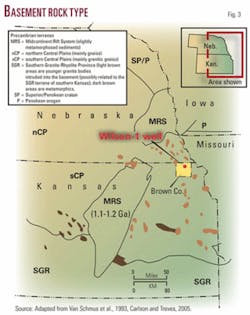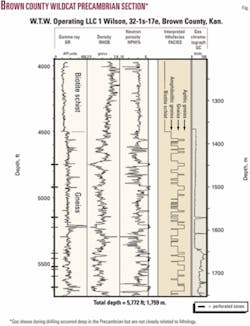Northeast Kansas well tests oil, gas possibilities in Precambrian rocks
Several thousand wells in Kansas have been drilled into the Precambrian basement, which usually signals the depth limit of drilling for oil and gas prospecting.
Most of these wells have penetrated only a few feet or tens of feet and a few cut several hundred feet of basement; 17 are known to have penetrated more than 1,000 ft into the basement, so the information on the Precambrian is surficial with exception of these wells and magnetic, gravity, and seismic data.
The COCORP seismic line and the earthquake monitoring system have added considerable data on the basement. The well data are sparse in the deeper parts of the basins and denser on the Nemaha anticline, Central Kansas uplift, and Cambridge arch. Oil produced from Precambrian rocks on the Central Kansas uplift is from granite wash, a porous weathered residuum, or fractures.
In late 2005 in far northeastern Kansas in the Forest City basin, W.T.W. Operating LLC drilled the No. 1 Wilson well to a total depth of 5,772 ft, 1,826 ft into the Precambrian basement on a venture testing the possibility of oil and gas in these crystalline rocks. Elevation of the well is 1,000 ft, and a bottomhole temperature of 135° F. was measured at TD.
This well in 32-1s-17e, Brown County, is the deepest drilled into Precambrian rocks except for the Nemaha Seneca well in 19-3s-11e drilled in 1929 and two wells in the Midcontinent rift system (MRS). The Wilson well was plugged after testing, but some new interpretations on the geologic history supplementing previous work are now possible. The nearest oil production to the Wilson well is from the Ordovician Viola formation and Siluro-Devonian Hunton limestones a dozen or so miles northwest and shallower Mississippian and Cherokee production 45 miles to the south and east.1 2
By any standard this well was a rank wildcat.
Regional geology
The Wilson well is the central Forest City basin,3 4 which extends northeast into Nebraska and Iowa and is a shallow cratonic basin filled with Paleozoic sediments ranging in age from Cambrian to Permian with a thin veneer of Cretaceous, Tertiary, and Pleistocene.
The lower Paleozoic sediments are mainly thin bodies of carbonates alternating with thin units of clastics with a fairly uniform thickness across the central part of the basin (Fig. 1). Near the end of the Mississippian and in the early part of the Pennsylvanian a thick sequence of alternating carbonates and clastics was deposited and preserved in the basin (Fig. 2).
A long interval of quietness occurred until the spread of the Cretaceous Interior Sea spilled over into eastern Kansas. Tertiary deposits are mainly clastics shed from the rising Rocky Mountains to the west, and the Pleistocene is residual material left from the Nebraskan and Kansan glaciers.
The basement in this part of the state is characterized by a granitic terrane with patches of metasediments. Ages obtained from several wells date the material from 1.579 to 1.649 Ga.5 This older terrane is intruded by younger granite bodies (≈1.340 Ga) and cross-cut by the younger MRS (≈1.100 Ga) (Fig. 3).
Basement rocks encountered
Samples from the Wilson well were clean, but only the fines were saved. The well encountered the Precambrian at 4,000 ft under the Upper Cambrian Reagan (Lamotte) sandstone. The Precambrian section consists of 510 ft of a brown, lustrous biotite schist with milky quartz interpreted as aplite veins.
The next 80 ft is a dark greenish gray crystalline amphibolite with a subtle change at 4,590 ft to a more gneissic texture to TD. No granite was encountered in contrast to other Precambrian wells in this part of the state.
A suite of wireline logs including gamma-ray, density, and neutron porosity log, was run that give diagnostic clues as to the rock composition of the Precambrian rock section (Fig. 4). The sharp break at 4,510 ft from biotite schist to layered gneisses was substantiated. There were several shows of gas after extensive testing, but the well was plugged and abandoned.6
The nearest Precambrian well, drilled in 1986, is the Hodgden & Associates No. 201 Mosquito Creek, in 20-5s-14e, Nemaha County, about 25 miles southwest. The Hodgden wildcat well encountered Precambrian quartz monzonite at 3,918 (2,673) ft.7 This well also was plugged and abandoned.
Precambrian production
Precambrian rocks underlying Kansas have been of interest for decades, but not as potential targets for oil and gas.
Most of these rocks are crystalline and nonporous so have few possibilities of containing petroleum with exception of those in the MRS, where source beds have been identified as have potential traps and reservoirs, and as a result several tests have been made in the rift.8 9
Oil has been produced in small quantities on the Central Kansas uplift from granite wash (a porous weathered residuum on the pre-Paleozoic surface) and from fractures in the crystalline basement.10
Gas from the Wilson well
Ten zones in the Precambrian between 4,744 ft and 5,683 ft were perforated with four shots per foot to test for gas.6
After acidizing, the well produced some low-Btu gas with swabbing operations (Table 1).
Assuming the recovered oxygen was contributed by atmosphere in the well tubing (and thus mixed with the gas coming out of solution during the swabbing) and sample bottle, any atmosphere was subtracted from the analyses. Likewise, the concentration of CO2 in the sample may be spurious, because of acidizing the well, so this, too, was subtracted and percentages recalculated to 100%.
The gas contained considerable nonflammable components of nitrogen, carbon dioxide, and helium, so it had a rather low 283 btu content. Even not considering the CO2, the btu was low at 495. The chemistry is strange with so much hydrogen; however, it is consistent with a thermogenic gas with a possible mixing of a microbial gas.6
The Precambrian has undergone considerable stress and strain during its epirogenetic history-first with the formation of the MRS in the Proterozoic, then several episodes of deformation in the Paleozoic, especially in early Pennsylvanian time and again near the end of the Permian. There were several periods of tilting and stress of the weight of the glaciers, so it seems likely that the basement is highly fractured.
Given this deformational history, it is suggested that fluids containing the hydrocarbon gas, which had been generated in Paleozoic sediments, migrated into the Precambrian fractures. The hydrogen possibly was generated in situ in the Precambrian basement.
The future
The occurrence of gas in the Precambrian crystalline rocks is a novelty, but can the gas be produced commercially?
Is the Wilson well the forerunner of a new oil and gas producing province in Kansas?
Only time and more tests will tell.
Acknowledgment
Thanks to P. Acker for the graphics.
References
- Newell, K.D., Watney., W.L, Cheng, S.W.L., and Brownrigg, R.L., “Stratigraphic and spatial distribution of oil and gas production in Kansas,” Kansas Geol. Survey, Subsurface Geology Ser. 9, 1987, 86 p.
- Newell, K.D., Watney, W.L., Stephens, B.P., and Hatch, J.R., “Hydrocarbon potential in Forest City Basin,” OGJ, Vol. 85, No. 42, 1987, pp. 58-62.
- Lee, W., “The stratigraphy and structural development of the Forest City Basin in Kansas,” Kansas Geol. Survey Bull. 51, 1943, 142 p.
- Merriam, D.F., “The geologic history of Kansas,” Kansas Geol. Survey Bull. 162, 1963, 317 p.
- Van Schmus, W.R., and others, “Transcontinental Proterozoic provinces,” in Reed, J.C., Jr., and others, eds., “Precambrian: Conterminous U.S.: The Geology of North America,” Vol. C2, GSA, 1993, pp. 171334.
- Newell, K.D., Doveton, J.H., Merriam, D.F., Sherwood Lollar, B., Waggoner, W.M., and Magnuson, L.M., “H2-rich and hydrocarbon gas recovered in a deep Precambrian well in northeastern Kansas,” Natural Resources Research, Vol. 16, No. 3, 2007, in press.
- Hodgen, G., personal communication, 2005.
- Berendsen, P., Doveton, J., Gerhard, L.C., Newell, K.D., Steeples, D., Watney, W.L., and Borcherding, R., “Preliminary geologic report of the Texaco 1 Poersch borehole,” OGJ, Vol. 86, No. 44, 1988, pp. 48-52, 54.
- Newell, K.D., Burruss, R.C., and Palacas, J.G., “Thermal maturation and organic richness of potential petroleum source rocks in Proterozoic Rice Formation, North American Mid-Continent Rift System, northeastern Kansas,” AAPG, Bull., Vol. 77, No. 11, 1993, pp. 1922-42.
- Walters, R.F., “Oil production from fractured Precambrian basement rocks in central Kansas,” AAPG Bull., Vol. 37, No. 2, 1953, pp. 301-313.
Bibliography
Carlson, M.P., and Treves, S.B., “The Elk Creek carbonatite, southeastern Nebraska-an Overview,” Natural Resources Research, Vol. 14, No. 1, 2005, pp. 39-45.
The authors
Dan Merriam ([email protected]) is a senior scientist (emeritus) with the Kansas Geological Survey at the University of Kansas. After working for Union Oil Co. of California, he taught at Syracuse, Wichita State, and Emporia State universities. He wrote the definitive book, “The Geologic History of Kansas,” and recently has been involved with geothermal studies and origin of ‘plains-type’ folds in the Midcontinent.
David Newell is an assistant scientist with the Kansas Survey in the Energy Research section. He joined the survey after a stint with Mobil Oil in Dallas. His research has been in stratigraphy, diagenesis, and petroleum geochemistry. His interests recently have been in following the coalbed gas play in eastern Kansas. He is senior author on the survey’s “Stratigraphic and Spatial Distribution of Oil and Gas Production in Kansas.”
John Doveton’s specialty is in the analysis of wireline logs. He has written several books on the subject including the widely used “Geologic Log Analysis Using Computer Methods” published by AAPG. After working with Mobil Canada, he joined the Kansas Survey, where he is now a senior scientist in the Energy Research section. He offers short courses in log analysis and teaches the subject regularly at the University of Kansas.
Mike Magnuson is a research associate in analytical chemistry in the Energy Research section at the Kansas Survey.
Barbara Sherwood Lollar is a geochemist in the Department of Geology at the University of Toronto, Canada. Her specialty is in the analysis of oil and gas samples.
Bill Waggoner is a petroleum geologist and owner and operator of W.T.W. Oil Co. Inc., which drills prospects in Texas, Oklahoma, and Kansas.





